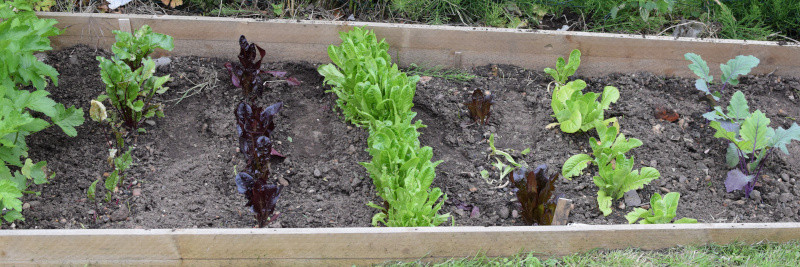What are the easiest vegetables to grow in the UK

Spring is fast approaching, as we can see from daffodil buds, flowering snowdrops, and crocuses, so now is the time to decide what to grow in the vegetable garden this year. Read on to see my choices for the easiest 10 vegetables suitable for growing in the UK. If you are reading in the US, USDA zones vary from 5 in parts of London to 6-7 in central zones and between 8 and 9 in Scotland.
10 of the easiest vegetables for the UK garden
1. Beetroot
![]()
Beetroot needs soil without stones and no manure. You can plant seeds outside from April onwards if the soil is workable.
How to sow and grow: Prepare a long row in soil and add a handful of compost but no manure. Sow seeds in a row an inch (2-3cm) apart. Fold the soil over the row and water them well. Small wine-coloured leaves soon appear, followed by a developing root visible above the ground. This is the beet forming. When it is about the size of a tennis ball, you can dig up the large ones and allow the others to mature and grow. You can also eat the young, delicious leaves fresh in salads too so this is a fantastic beginner’s vegetable.
2. Chili peppers
![]()
Chili or Hot peppers need warm soil indoors to start them off, but you can put them on a sunny windowsill in April and then transplant them outside when the temperatures pick up.
How to sow and grow: Use some compost to start off the seeds indoors. Water the pot, pop in 2-3 seeds per pot, and then cover it with a plastic bag, to conserve both heat and moisture. Place the pot in the airing cupboard or a sunny window. When seedlings appear, harden them off on warm days by placing them outside to get used to them. Then when all frost risk has passed, transplant them into a warm, sunny position and watch the peppers form. You can leave them to dry on the plant or hang them to dry indoors, where you can use them whenever you feel like it.
3. Chives
![]()
Chives provide tasty greens when there are few greens available, and they can grow every year from January onwards in a sunny spot outdoors. They like fertile soil and do not mind a bit of frost, so these can add a fresh taste to your scrambled eggs in winter.
How to sow and grow: Sow seeds inside if the soil is frozen. You can transplant them out when the soil is workable or plant directly outside. Choose a sunny spot and sow plenty of seeds so you can grow them in bunches. Continue to sow seeds, and you can keep picking until they go to flower. They will come back year after year if you don’t dig them up.
4. Courgettes (zucchini)
![]()
Courgettes grow only in frost-free conditions, but once they start growing, you can harvest them every few days if your soil is fertile enough.
How to sow and grow: Plant one seed sideways in a pot indoors in late April and keep it warm until the seedling emerges. Keep it well watered and transplant it to a bigger pot if the roots show at the end of the pot. Only plant outside in soil after all frost risk is gone. Fill a deep pot, or dig a patch in soil with as much manure, compost, and rotted leaf mold as possible. These hungry plants need lots of watering, too, so make sure they are near the tap or water butt. Gorgeous flowers will appear first, which are edible, but if you eat them, no courgettes! Huge leaves, pretty flowers, and lots of vegetables all summer long. Cut the fruit with sharp scissors and keep picking until the summer ends. If you go on holiday, you will return to marrows, not courgettes, so you will be making marrow jam.
5. Annual herbs
![]()
Annual herbs, like basil, are sown, grown, picked, and die off in one year. Perennial herbs mean they last for several years, even in the UK winter outdoors, and we will look at these in another article.
How to sow and grow: Choose annual herbs that like the same conditions and plant them together. Basil, parsley, coriander (cilantro), and tarragon all grow well together. Sow seeds indoors in a warm place now and grow them to at least 4-6 inches (10-16 cm) before planting outside. Make sure the soil is fertile for all of these. If you have homemade compost, dig a handful into the soil for each herb and then plant them outside. Water them well initially and regularly or they tend to go to seed, which is known as “bolting”. Pick them all summer long, pick edible flowers from basil and tarragon can be re-potted in new soil at the end of the summer and taken indoors to overwinter.
6. Rocket (or Wild Rocket)
![]()
Rocket can be eaten year-round if you keep saving and sowing seeds. It enjoys sunshine and rich soil, but it will self-seed in any garden.
How to sow and grow: Buy good seeds from the start if you want to save seeds. They are tiny and black, so plant a handful of them directly into the soil and water them well at first. However, rocket has deep roots, so when established you do not need to water too much except in very hot weather. The leaves can be picked continuously but they will flower with unusual yellow cross shapes, and if you want to save seeds, allow them. The seed pods are easily cut and dried. You can keep planting them all year round in places like Kent, where I live. If the ground is frozen, my rocket still braves the weather here. So this is my winter salad of choice.
7. Salad Leaves
![]()
Best sown in spring and summer, you can plant different varieties for fun and to add variety to your salads.
How to sow and grow: Most salads and lettuces will grow in any sunny patch, so sow lots of seeds and keep sowing for a long supply of greens. Water them well initially and then at least once a week but more in a hot spell. Sow seeds every few weeks to keep a constant supply.
8. Squashes and Pumpkins
![]()
These come in many shapes and sizes. Winter squashes can be stored, while summer squashes should be eaten fresh. Pumpkins are usually used and eaten around Hallowe’en.
How to sow and grow: From May onwards in the UK, the soil will be warm enough to cultivate squash and pumpkins direct although you can sow indoors if you have space. Allow plenty of space in the veg patch for these plants. They will sprawl all over your vegetable patch, with tendrils attaching themselves to anything. The traditional Mexican 3 Sisters method grows beans, corn, and squash altogether as beans add nitrogen, and squash enjoy that. Cut the first fruit when it’s small to encourage bigger growth from the rest. Keep cutting until the first frosts, and you can store pumpkins and winter squash for several months.
9. Sunflowers
![]()
Sunflower seeds come from the pollinated sunflower and are processed to make oil for cooking but they can also be roasted and eaten as a tasty snack.
How to sow and grow: Summer wouldn’t be summer without large sunflowers, would it? You can also eat the seeds, so if you plant a row of them, you have healthy, tasty dried snacks too.
FAQs
What are the fastest vegetables to grow?
10. Radishes
![]()
Radishes grow so quickly that traditionally gardeners sow a row of them to remind them the slower-sprouting parsnips are close to the row. For children who want quick results, try a row of radishes and peas because they are interesting. First, they produce shoots that climb using tendrils, then gorgeous flowers, followed by pods, and children can tie the tendrils around the pea poles. I also recommend pumpkins for their unusual spreading habit because children will think a giant plant has invaded the garden. They can be shown how to turn the pumpkin for fruit to ripen and see how much water such a big plant needs.
Conclusion
It’s time to find the gardening gloves, wash out the greenhouse if you have one, and get the plant pots cleaned, ready for new seeds. Start seeds indoors but do not plant outside until the risk of frost has gone. If you have planted an easy vegetable missing from my list, please let me know! Happy planting.


